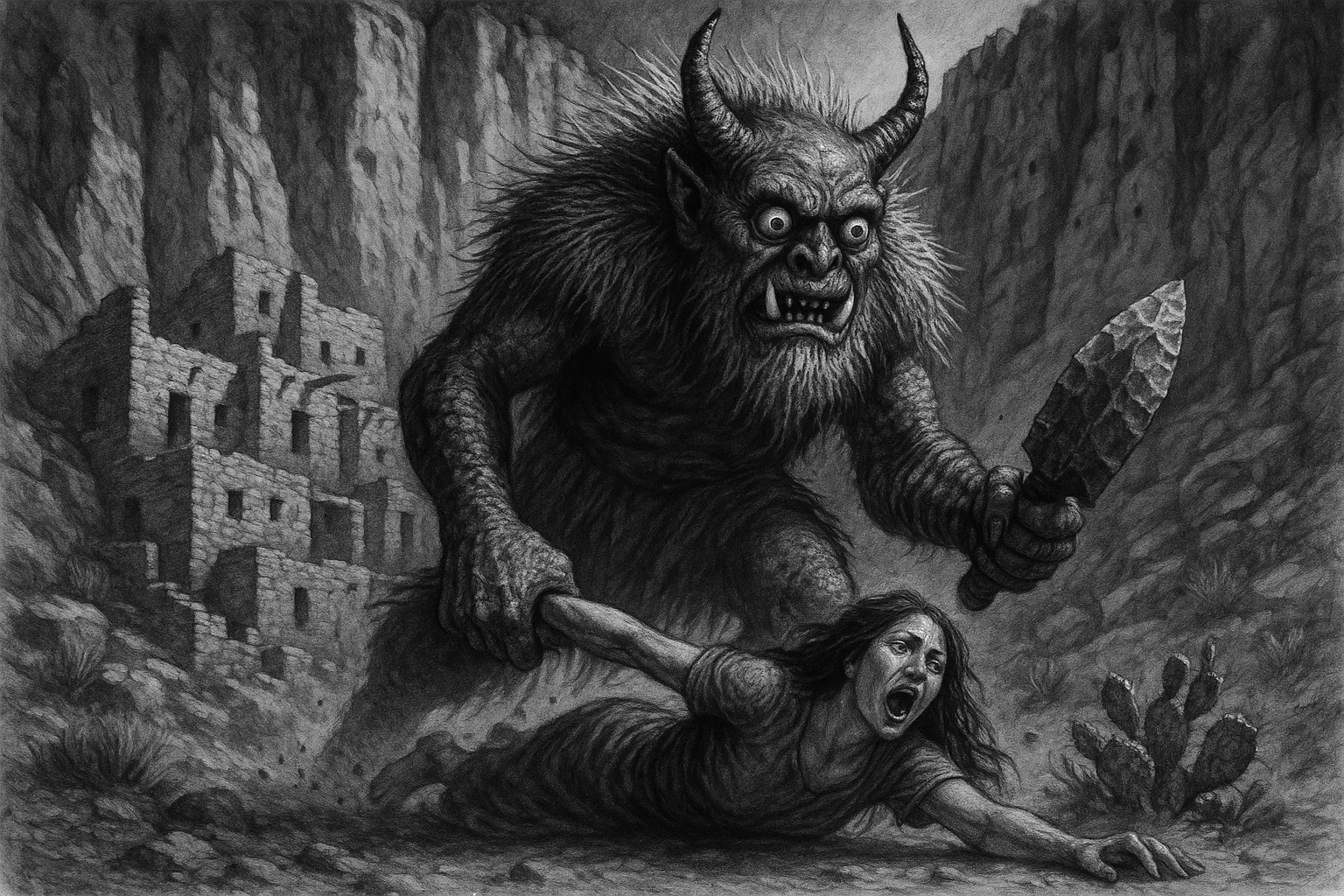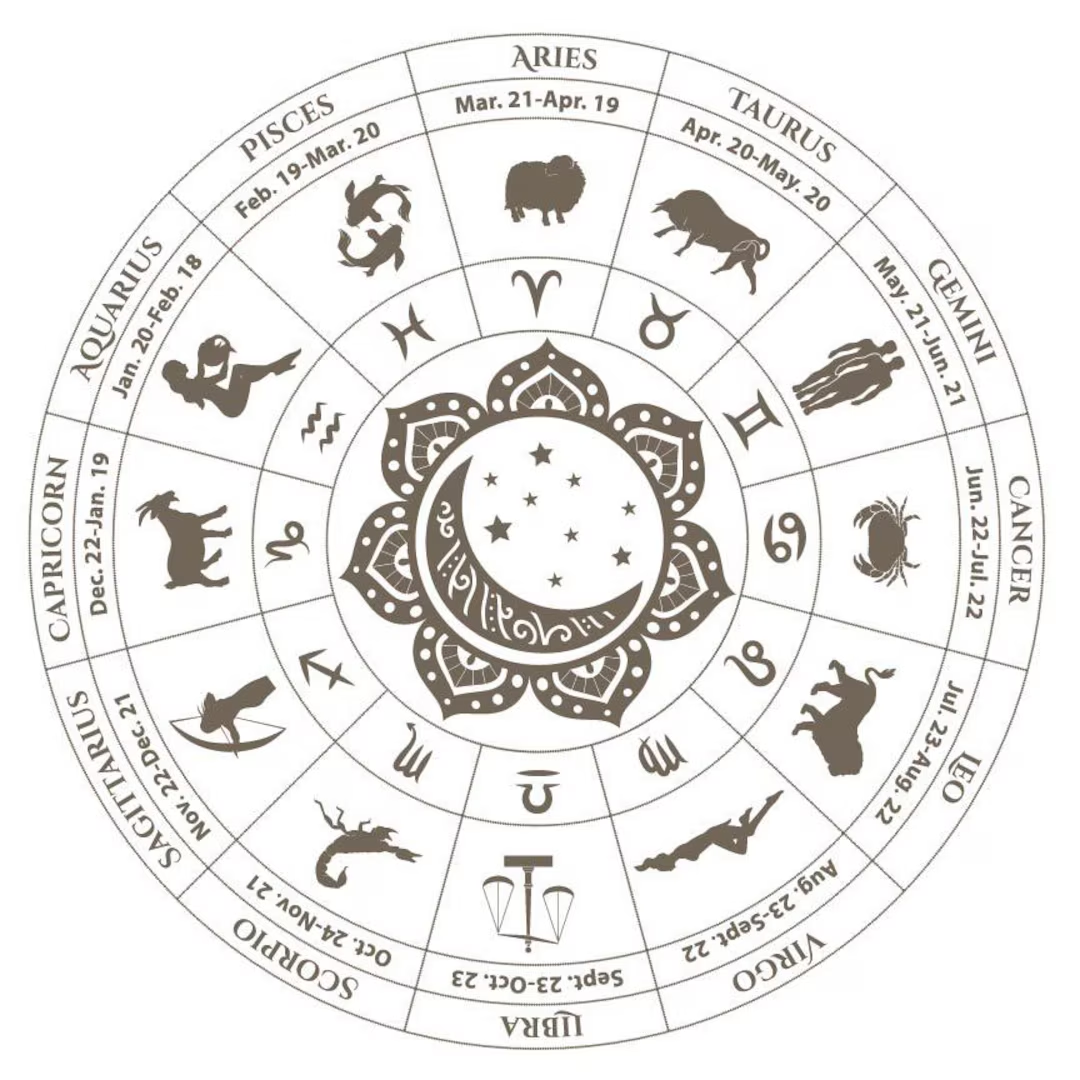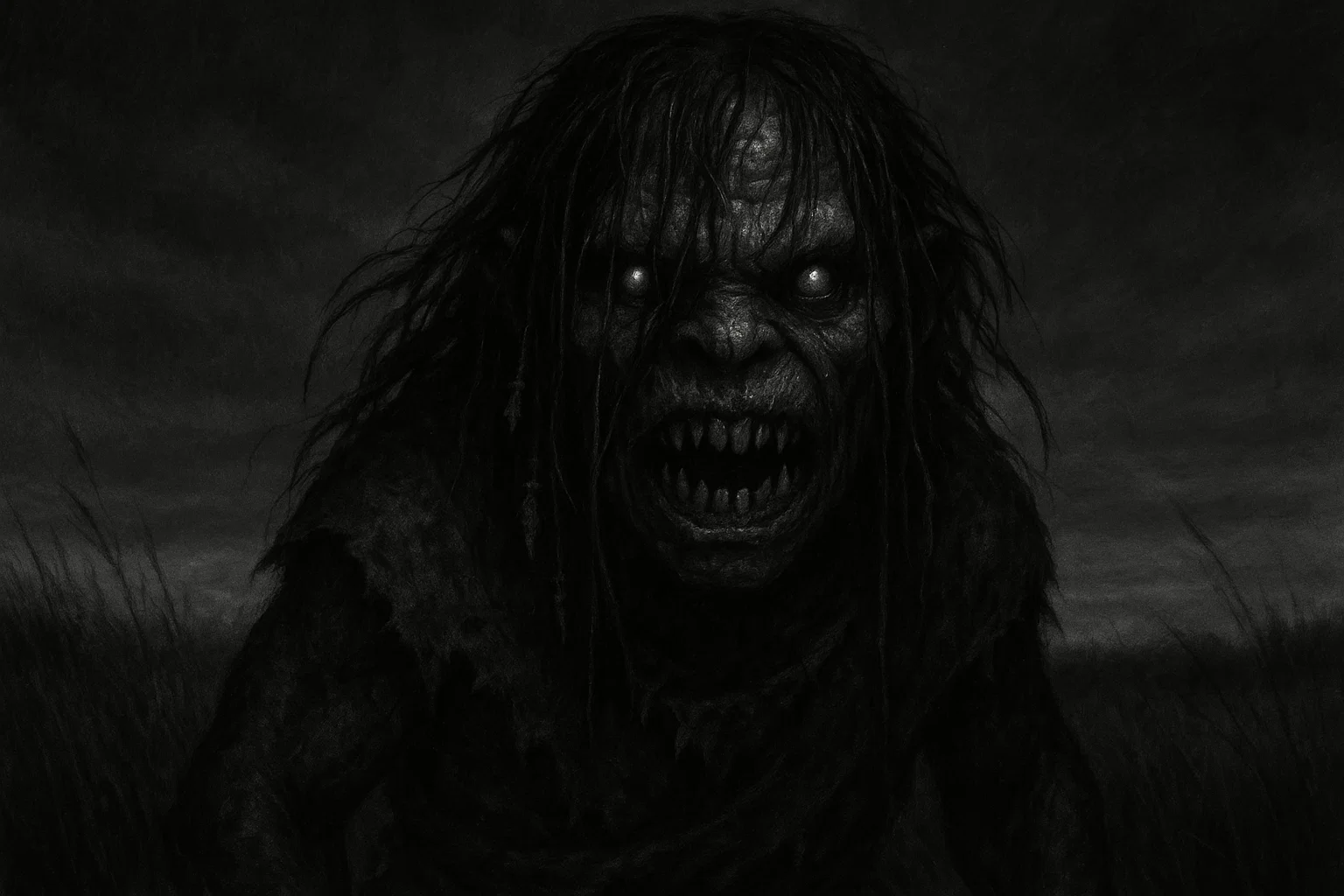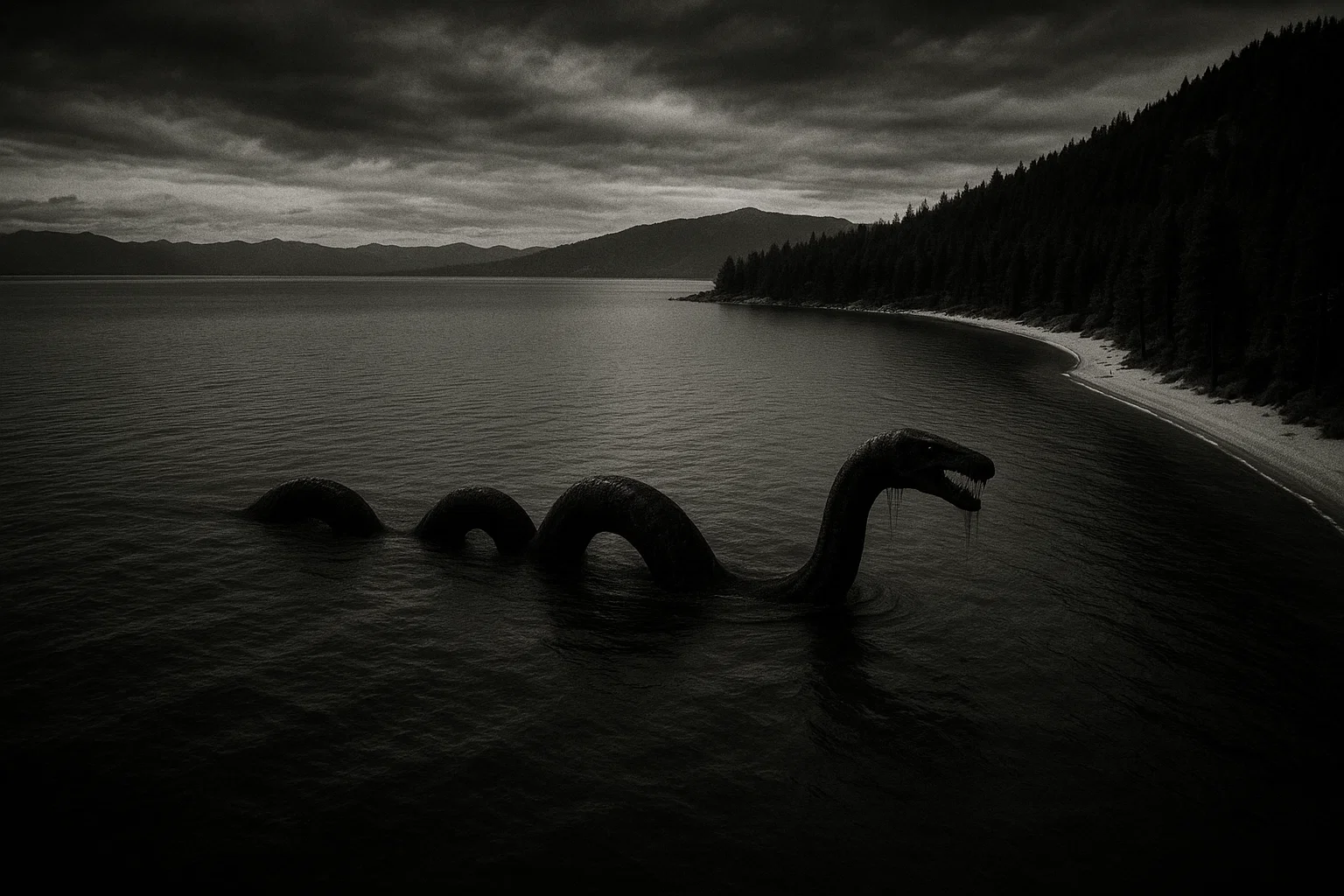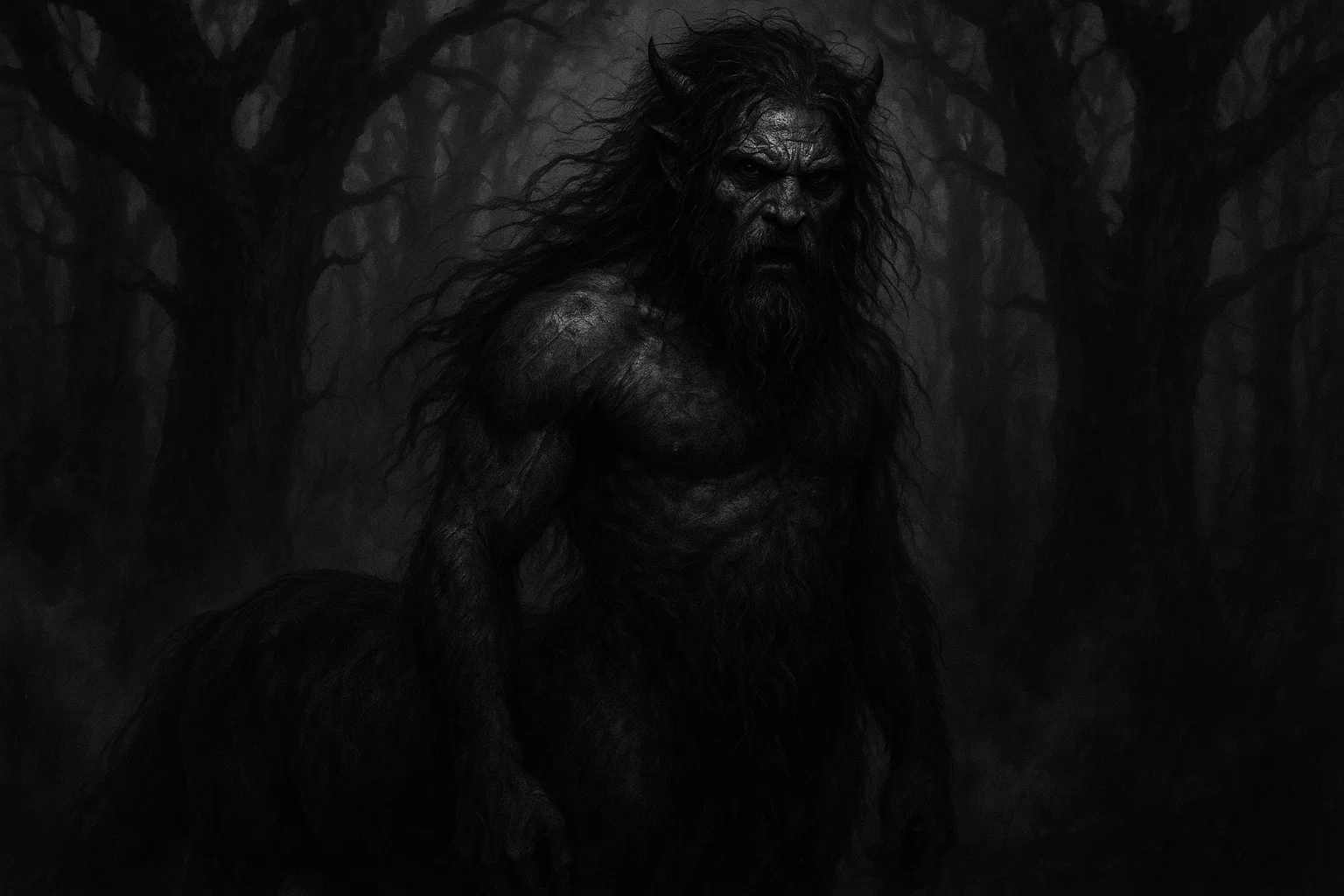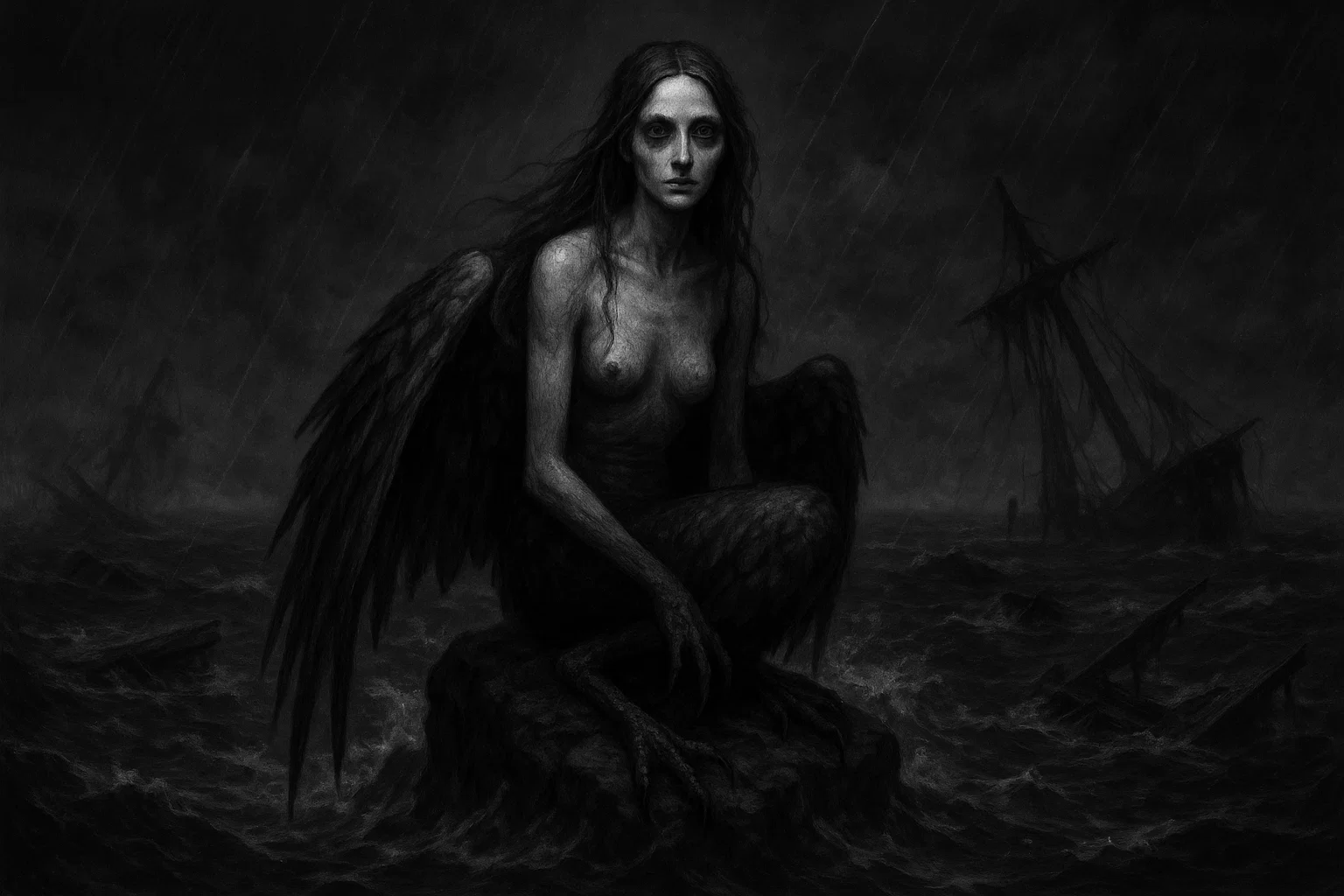Átahsaia is a strange cryptid/creature from the mythology of the Zuni people (indigenous to the southwestern United States). This entity is described as a giant cannibalistic demon that preys on humans and other beings.
Stories of Átahsaia appear in traditional Zuni folktales, where it serves as a symbol of danger and moral warning. The creature combines physical enormity with malevolent traits, often depicted in narratives involving deception and consumption.
Summary
Overview
| Attribute | Details |
|---|---|
| Name | Átahsaia |
| Aliases | A’tahsaia, Atasaya |
| Threat Level | Predatory; known for cannibalism of humans and other demons |
| Habitat | Arid mesas, cliffs, and caves in the southwestern United States, particularly Zuni Pueblo region in New Mexico |
| Physical Traits | Giant humanoid, several times taller than a human; torso as large as an elk; long grey hair like porcupine quills; thick, horned skin; black and white scaled arms; swollen red face with unblinking bulging eyes; possible yellow tusks and long talons |
| Reported Sightings | Primarily in Zuni oral traditions; no verified modern locations beyond southwestern New Mexico folklore sites like Héshokta (Town of the Cliffs) |
| First Documented Sighting | Ancient Zuni oral traditions, predating written records; earliest transcribed accounts from late 19th century ethnographies |
| Species Classification | Demon or spiritual entity with physical manifestation; speculative humanoid |
| Type | Terrestrial |
| Behavior & Traits | Cannibalistic; deceptive liar; armed with giant flint axe or knife; nocturnal hunter; preys on the isolated and vulnerable |
| Evidence | Oral narratives and folktales; no physical specimens, footprints, or photographs |
| Possible Explanations | Mythological representation of natural dangers like starvation or predators; cultural cautionary tale against greed and isolation |
| Status | Ongoing mythological figure in Zuni culture; no active modern reports |
Who or What Is Átahsaia?
Átahsaia is a giant cannibalistic demon in the religion and mythos of the Zuni people of the southwestern United States. The entity is portrayed as both a spiritual being and a physical monster that inhabits remote areas.
In Zuni folklore, Átahsaia embodies evil through its insatiable hunger for flesh, targeting humans and other supernatural creatures alike. The name Átahsaia can refer to a specific demon or a class of such beings, highlighting its role in broader demonic hierarchies.
Traditional stories depict Átahsaia as a solitary hunter who uses cunning to lure victims. It often appears in tales set in ancient Zuni villages, where it disrupts communities by abducting individuals.
Unlike benevolent spirits in Zuni cosmology, Átahsaia represents unchecked malevolence, often countered by cultural heroes or clever survivors. Ethnographers in the late 19th century recorded these accounts, preserving them in written form while noting their oral origins.
Your Personalized, Hyper Accurate Moon & Astrology Reading
Limited time offer: Get your FREE, fully personalized Moon & Astrology Reading that takes astrology to a whole new level. Discover the secret depths of your personality, relationships, and true purpose in life.
What Does Átahsaia Look Like?
Átahsaia is consistently described in Zuni lore as an enormous humanoid figure, far exceeding human proportions. The creature stands several times taller than an average person, with some accounts estimating its height at over 10 feet.
Its torso is likened to that of a large elk, providing a broad, imposing frame that highlights its physical dominance. This size allows Átahsaia to overpower victims effortlessly, as seen in stories where it crushes shelters or seizes multiple people at once.
The entity’s skin is thick and tough, resembling hardened leather that resists injury. Knuckles protrude like horns, adding to its menacing silhouette.
Much of its body is covered in long grey hair, sharp and prickly like porcupine quills, which serves both as insulation in arid environments and as a defensive feature against close encounters.
The arms are particularly distinctive, muscular and elongated, covered in black-and-white scales that evoke reptilian armor. These limbs end in hands capable of wielding massive weapons, such as a flint knife broad as a man’s thigh and twice as long.
Átahsaia’s face is one of its most terrifying aspects: swollen and red, with bulging eyes that never blink, creating an unnatural, piercing stare. This unyielding gaze is said to hypnotize or intimidate prey from a distance.
A minority of tales add yellow tusks protruding from its mouth, used for tearing flesh, and long talons on fingers and toes for gripping rocky terrain or slashing at escapees.
You May Also Like: Alastor: Greek Avenger Turned Executioner of Hell
Habitat
Átahsaia is associated with the rugged landscapes of the American Southwest, particularly the arid regions around Zuni Pueblo in western New Mexico. This area features high mesas, deep canyons, and sheer cliffs, providing ideal cover for a stealthy giant.
Traditional stories place the creature in remote caves and cliff dwellings, such as those near Héshokta, an ancient Zuni site known as the “Town of the Cliffs.” These locations, elevated above 6,000 feet, offer vantage points for surveying human settlements below while remaining hidden.
The environment is a semi-arid desert with sparse vegetation, including junipers, piñon pines, and cacti that dot rocky outcrops. Summers bring intense heat exceeding 100°F, while winters drop to freezing, with occasional snow on higher elevations.
This harsh climate mirrors Átahsaia’s endurance, as its thick, scaled skin and quill-like hair would insulate against extremes. Water sources are limited to seasonal arroyos and hidden springs in canyons, where the demon might ambush travelers seeking refreshment.
Fauna in the region includes mule deer, coyotes, and small mammals like jackrabbits, which could supplement Átahsaia’s diet between human victims. Larger prey, such as mountain lions, roam the mesas, but lore suggests the demon dominates all, even consuming fellow spirits.
Human settlements, like the modern Zuni Pueblo, cluster in valleys for farming corn, beans, and squash, drawing Átahsaia closer during harvests when isolation increases vulnerability.
Cliffs and lava flows serve as natural barriers, further enhancing the creature’s elusiveness. Ancient petroglyphs in nearby areas, depicting humanoid figures with exaggerated features, may echo Átahsaia motifs, though interpretations vary. The terrain’s isolation fosters the myth’s persistence, as vast distances between villages amplify fears of the unknown.
Today, the habitat overlaps with protected lands like El Malpais National Monument, where volcanic badlands create labyrinthine hideouts. Vegetation thins at higher altitudes, exposing bare rock that Átahsaia’s talons could navigate silently.
Átahsaia Sightings
| Date | Place | Witness Details | Description | Reliability |
|---|---|---|---|---|
| Ancient (pre-1500 CE) | Héshokta, Zuni Cliffs, New Mexico | Unnamed Zuni villagers; oral tradition passed through generations | Giant demon abducts two sisters from cliff village, pursues them into canyon; uses flint knife to hunt | Medium: Consistent in multiple oral accounts, but lacks contemporary verification |
| Late 19th century | Zuni Pueblo vicinity, New Mexico | Ethnographer Frank Hamilton Cushing and Zuni informants | Recounted tale of Átahsaia consuming travelers; physical form with scaled arms observed in story | Medium: Documented in ethnographic records, reliant on secondhand narrative |
| Circa 1900 | Mesa caves near Zuni River, New Mexico | Zuni elders during tribal ceremonies | Entity emerges from cave, eyes unblinking; attempts to lure children with lies | Low: Ceremonial context may embellish for teaching; no independent corroboration |
| 1930s | Remote arroyo near Gallup, New Mexico | Anonymous herder family; shared in community gathering | Massive figure with quill hair spotted at dusk; carries axe, emits guttural calls | Low: Single family report, undocumented beyond local retelling |
| 2011 | Fictionalized account in online forum | Pseudonymous poster on Reddit (r/nosleep) | Summer encounter with stalking demon; describes red face and talons | Low: Creative writing prompt, not factual sighting |
The Abduction at Héshokta (Ancient Zuni Tradition)
In a classic Zuni story, a powerful demon named Átahsaia sets its sights on two lovely sisters who live in an ancient village nestled in the cliffs. One sunny summer morning, the older sister goes out to pick cactus fruit. Still, she is suddenly grabbed by the demon hiding among the rocks.
This fearsome creature is so large that it can’t fit into narrow caves, and it drags her toward its lair, causing the rocky ground to scrape against its scaled arms. The younger sister, seeing this unfold, decides to follow carefully and uses her cleverness to keep track of where they are going.
Átahsaia tries to trick the younger sister by pretending to be a lost traveler. Still, its cold, unblinking eyes give away its true nature. To escape, the sisters use the surroundings to their advantage: the younger sister finds a small crevice to hide in, too tight for the giant to reach her. In comparison, the older sister distracts the demon by throwing stones.
The demon lets out a thunderous roar that echoes through the canyon as it swings its massive knife, which is as wide as a human thigh.
You May Also Like: Is Batsquatch Real? The Mount St. Helens Mystery
Ethnographic Recounting by Cushing (Late 1880s, Zuni Pueblo)
Frank Hamilton Cushing was an early anthropologist who lived among the Zuni people in the 1880s. During his time there, he heard many stories about a creature called Átahsaia. According to local informants, this creature was seen as a constant danger, known to appear from lava caves in search of isolated hunters to prey upon.
One elder shared a haunting tale about a warrior who got lost and was conentity’s Átahsaia, leaving behind only scattered bones near the Zuni River. People said the creature had grey, quill-like feathers that rustled eerily in the wind, warning victims too late of the danger approaching.
Cushing also mentioned that Átahsaia carried a black symbol of the violence it represented. The stories about this encounter were later shared among villagers, who often heard its call mimicking the voices of their loved ones, tricking them into thinking someone they knew was nearby.
Herder Family Encounter Near Gallup (1930s)
In the Dust Bowl era, a Zuni family who herded sheep near Gallup, New Mexico, had a friÁtahsaia’sncounter.
One evening, the father noticed a large, shadowy figure with a swollen, red face hiding among the rocks. This eerie figure, with bulging eyes, was watching their flock and approached them with long, strange movements, holding an axe that shimmered in the fading light.
Terrified, the family quickly ran to their home and locked the door as unsettling whispers echoed outside, imitating the mother’s voice to trick her into stepping outside.
People described the figure as about the size of an elk, with a terrifying gaze that made them tremble with fear.
Awaken XT is unlike anything you’ve ever tried before…
…it’s based off a closely guarded formula that’s said to be able to supercharge your pineal gland and help you access your untapped inner power. With it’s unique blend of extremely hard to source ingredients, Awaken XT helps support the healthy functioning of your pineal gland, as well as your other organs in your body.
Evidence & Investigations
Evidence for Átahsaia consists entirely of oral traditions and ethnographic transcriptions, with no tangible artifacts, such as bones or tools, directly attributed to the entity.
Zuni folktales, compiled in works such as Frank Hamilton Cushing’s “Zuni Folk Tales” (1901), provide the primary source material. These narratives detail physical encounters, weapon descriptions, and behavioral patterns, but they function as cultural repositories rather than empirical reports.
Petroglyphs near Zuni Pueblo, dated to 1000–1500 CE, feature oversized humanoid figures with exaggerated limbs, which some interpreters link to Átahsaia motifs.
Cushing’s immersive fieldwork in the 1880s involved living among the Zuni and recording over 600 tales, including multiple variants of Átahsaia. His accounts emphasize the demon’s symbolic role in teaching ethics, such as the dangers of isolation.
Later ethnographers, like Matilda Coxe Stevenson in the 1890s, corroborated this evidence, noting consistencies in physical traits across informants. The Bureau of American Ethnology sponsored these efforts, aiming to document vanishing oral histories amid colonization.
In the 20th century, folklorists such as Ruth Benedict analyzed Átahsaia in “Zuni Mythology” (1935), framing it as a cautionary archetype against cannibalism taboos.
You May Also Like: Beast of Bray Road: Wisconsin Creepiest Cryptid?
Theories
Theory of Cultural Caution Against Isolation
Zuni stories portray Átahsaia as a fearsome creature that targets those who wander off alone, reflecting the community’s view of solitude. In the dry Southwest, where finding water and food can be really tough, these tales serve as warnings against isolating oneself.
Átahsaia idemon’s for mimicking family members’ voices to lure people away, highlighting the importance of staying close to one another for safety. This interpretation aligns with what researchers believe about these stories evolving to help people stick together during hard times, such as migrations or droughts.
The story elements, like Átahsaia’s unblinking eyes, symbolize hidden dangers and remind listeners to be aware of threats around them, even if those threats aren’t physically present.
Misremembered Encounters with Rogue Individuals
Some researchers suggest that the legend of Átahsaia might come from ancient memories of outcasts or raiders in the Southwest before European colonization.
Archaeological evidence, such as mass graves found near Zuni sites, indicates conflicts between tribes. It’s believed that survivors may have exaggerated Átahsaia’sies into fearsome, monstrous beings.
A tall warrior, marked by battle scars and carrying a large stone knife, could have influenced descriptions of Átahsaia’s terrifying features, such as its scaled arms and axe.
Zuni stories also tell of “cursed men” who were exiled for serious wrongs, such as stealing from graves. Over time, these figures may have transformed into large, demonic giants in the stories. This helps explain why Átahsaia is described as being humanoid rather than an animal.
As stories were passed down through generations, details could have changed, making a 7-foot-tall raider seem like a 10-foot-tall monster. This transformation fits the Zuni landscape, where raids from cliffs were possible, adding to the myth’s local flavor.
Symbolic Representation of Environmental Starvation
Átahsaia is a creature tied to the idea of cannibalism, reflecting the harsh realities of famine in the Southwest. It symbolizes the desperate hunger people experience when times are tough.
The Zuni people depend on unpredictable rains for their farming, so when crops fail, it has sometimes led to extreme and disturbing behaviors like cannibalism, which has been found in ancient sites like those of the Anasazi.
This demon is portrayed as always hungry and thin, which mirrors how society views cannibalism as something taboo and terrifying, serving as a warning against falling into such desperate acts. Its features, like quill-like hair and scaly skin, remind us of plants that grow in the desert, connecting the “myth to th” local environment.
From a cultural perspective, Átahsaia serves as a lesson about managing resources wisely. Different stories sometimes show it preying on other demons to highlight the dangers of greed and how it can disrupt community harmony.
Undiscovered Primate Relict Population
Some people think that Átahsaia, a creature from folklore, might be a type of ancient human-like being, similar to the Bigfoot stories found in Native American traditions.
In the Southwest, there are deep lava tubes that could hide undiscovered primate species. Over time, stories may have exaggerated features of these creatures, like describing them with scaled arms when they could actually have matted fur, or mistaking a branch they carry for an axe.
Additionally, there have been reports of footprints in soft dirt that resemble those attributed to Sasquatch, although they haven’t been verified. This idea suggests that ancient relatives of a large ape, known as gigantopithecines, may have migrated to desert areas and adapted to hunting humans when the opportunity arose.
The consistency of Zuni stories about large creatures aligns with other giant-sighting reports from tribes like the Navajo, suggesting a shared ancestry in these myths.
However, the lack of fossil or DNA evidence has made it difficult to prove these claims, positioning Átahsaia as a fascinating piece of cultural storytelling rather than a confirmed species in zoology.
You May Also Like: Tahoe Tessie: The Mysterious Lake Monster of the Sierra Nevada
Comparison with Other Similar Cryptids
| Cryptid | Origin/Region | Physical Traits | Behavior | Key Differences from Átahsaia |
|---|---|---|---|---|
| Wendigo | Algonquian tribes, Great Lakes/Northeast US and Canada | Emaciated giant with antlers, glowing eyes, sharp teeth | Cannibalistic spirit possessing humans; mimics voices to lure | Shape-shifts from humans via greed; tied to winter famine, not desert caves |
| Wechuge | Athabaskan people, Northwest Pacific Coast Canada | Ice-hearted giant, bear-like form, elongated limbs | Possesses individuals into cannibal monsters; hunts in isolation | Linked to animal spirits rather than innate demon; aquatic influences absent in Átahsaia |
| Stone Giants (Geno’sgwa) | Iroquois/Seneca, New York and Ontario | Rock-skinned humanoids, twice human height, impenetrable scales | Winter-associated cannibals; hurl boulders at villages | Body armored in stone, not quills/scales; group hunters versus solitary Átahsaia |
| Dzoavits | Shoshone, Great Basin US (Wyoming/Nevada) | Stone-clad giants, massive build, club-wielding | Raids tribes for captives; cannibal feasts on mountaintops | Uses clubs over flint knives; migratory raiders, less deceptive than Átahsaia’s lies |
| Matlox | Nootka, Vancouver Island Canada | Hairy biped with fangs, claws, dog-like head | Ambush cannibal in mountains; devours hikers | Black stiff hair, no red face or tusks; coastal forests, not arid mesas |
| Nimerigar | Shoshone/Paiute, Wyoming/Colorado plains | Dwarf-sized (child height), arrow-wielding warriors | Aggressive cannibals terrorizing tribes; use poison darts | Tiny stature versus giant; pack attackers, lacks Átahsaia’s spiritual demon aspect |
| Yi’ Dyi’ Tay | Tillamook, Oregon coast US | Wild man giant, fur-covered, elongated arms | Forest lurker eating humans; elusive tracker | Coastal wild man without axe or scales; more ape-like, less demonic |
| Giwakwa | Wabanaki/Abenaki, Northeast US/Canada | Ice giants with frozen hearts, pale skin | Transforms via crime/cannibalism; eternal winter hunters | Ice-based curse origin; group of giants, contrasts Átahsaia’s singular cave dweller |
| Si-Te-Cah | Paiute, Lovelock Cave, Nevada | Red-haired giants, tall and robust | Cannibal tribe driven out; used caves for ambushes | Historical tribe with fire-starting tech; red hair, no quills or unblinking eyes |
Is Átahsaia Real?
Átahsaia is an important figure in Zuni mythology, a tradition passed down through stories for many years. While there’s no physical evidence—such as bones or tracks—to prove its existence, the stories and beliefs about Átahsaia are deeply rooted in Zuni culture. They convey important lessons about community values and social taboos.
People have different ideas about what Átahsaia might represent, ranging from warnings about famine to hints of ancient creatures that roamed the area.
However, the main focus seems to be on its role in storytelling rather than proving it exists in reality. It appears more likely to be a part of Zuni folklore, rich with cultural significance, rather than an actual monster lurking in the shadows.

